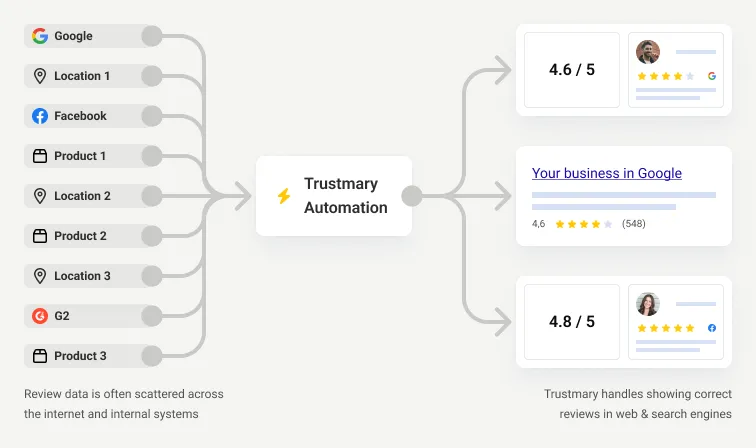Review Syndication: Best Practices


Online reviews are influencing buying decisions. A massive 93% of consumers admit that reviews impact their purchasing choices.
But here’s the thing: collecting reviews on your own website is great, but what if those reviews could do more?
That’s where review syndication comes in. By sharing your customer reviews across many channels, you can maximize their impact, build trust, and ultimately impact the bottom line by increasing revenue.
In this post, I’ll break down what review syndication is, how it works, and why it’s essential for brands that want to expand their reach.
What Is Review Syndication?
In all honesty, review syndication is just a fancy word for using customer experiences, aggregated ratings, reviews, and visual social proof content provided by customers in all imaginable platforms: Websites, landing pages, social media content, and on sales decks.
There are a few ways to look at review syndication. Depending on your industry and size of business, it might mean:
- Using translated reviews on different language versions
- Sharing your brand reviews with retailer sites that sell your products
- Combining customer feedback collection with review collection
- Enabling customers to leave reviews on the platforms of their choosing
- Using video reviews on review widget
- Sharing reviews across brand websites and retail channels
- Importing reviews from multiple sources and adding them to website
Trustmary's dynamic review widget is a great tool to 90% of use cases!

Review Syndication Process: Example Case
A brand has reviews on multiple sites. It wants to make sure all customers see all of their reviews, as their visibility on different review sites differ. It also wants to collect new reviews to all of these platforms. The company has been thinking about expanding to new markets, but lacks social proof in those.
In this case, the solution would be to:
- Import reviews to Trustmary
- Create a star review form that features all review sites on the thank you page
- Create a review marketing strategy
- Create landing page for a new market, creating a review widget with existing reviews and enabling the translation option

This strategy utilizes all of the existing social proof, which leads to lower spend and maximum visibility.
It also ensures that potential customers see relatable reviews wherever they shop online, whether they’re browsing on your site or looking you up from a review site.
Have a look below at what our Product Owner and Co-founder Arttu Haho has to say about the best use cases of Trustmary's dynamic review widget.
How Does Review Syndication Work?
The process of review syndication involves several key steps:
- Collecting Reviews: Brands gather user-generated content (UGC), including star ratings, written reviews, and photos or videos from customers. This is typically done through post-purchase surveys, prompts on the website, or even incentive programs.
- Moderation and Authentication: To maintain authenticity, reviews undergo a moderation process. This ensures that only genuine, unaltered reviews are shared across different platforms. Moderation also helps filter out spam or fraudulent content, ensuring a reliable experience for future customers.
- Distributing to Retailers: Once authenticated, the reviews are shared with retailers who sell the product. These reviews are then displayed on the retailer’s product pages, giving shoppers valuable insight while boosting credibility for the brand and retailer alike.
- Consistent Display: On both the brand’s and retailer’s websites, reviews are displayed consistently, helping customers see the same feedback no matter where they shop.
Why Your Brand Needs Review Syndication
Review syndication offers plenty of advantages for businesses looking to increase their reach and build trust with customers. Let’s explore the top benefits.
1. Expand Your Audience
Syndicating reviews allows your brand to appear across multiple online marketplaces and retailer websites, exposing your products to a broader audience. Shoppers who might never visit your website can still read your reviews on their favorite e-commerce platform. This added reach means you’re getting more eyes on your product—and that’s always a win.
2. Boost SEO Performance
One of the hidden gems of review syndication is its positive impact on search engine optimization (SEO). Customer reviews often include long-tail keywords, which are product-specific phrases that shoppers search for. By syndicating reviews, you can improve your product’s visibility on search engines, both on your own site and retailer sites.
Plus, syndication doesn’t result in duplicate content penalties from search engines if done correctly. In fact, there are no duplicate content penalties, but
Retailers are careful to ensure that Google doesn’t flag syndicated content as duplicate by following best practices such as linking back to the original review.
3. Build Trust and Drive Sales
Shoppers want to know what other people think about a product before they buy. Syndicating reviews ensures that authentic feedback is visible wherever your product is sold. More reviews equal more trust, which ultimately leads to higher conversions and increased sales.
4. Stay Competitive
Without syndication, you may be losing out to competitors who are already syndicating their reviews. Having reviews on multiple platforms helps you stand out from competitors that don’t have as much customer feedback visible, leveling the playing field and giving you a competitive edge.
Caution: Avoid These Practices
While syndication is powerful, it comes with a few challenges. Here's what to keep in mind:
1. Duplicate Content
Reviews influence SEO efforts, but abusing product reviews will cause issues. The worst-case scenario is that there are manual actions by Google. This is not probable, but possible.
The issue can be caused by duplicate content. To avoid this, retailers and brands should ensure that syndicated reviews are linked back to the original content or tagged properly with a noindex meta tag to prevent search engines from indexing them as duplicates.
2. Maintaining Authenticity
It’s important to maintain the integrity of reviews as they are syndicated. In other words, don't censor reviews your reviews and only include the positive reviews.
This means reviews shouldn’t be edited, filtered, or manipulated during the syndication process.
Authenticity builds trust with your audience and ensures that your reviews continue to drive conversions.
3. Managing Reviews Across Platforms
Once reviews are syndicated, brands must track and manage feedback on multiple platforms. This can be a logistical challenge but is essential for maintaining consistency and ensuring that customer concerns are addressed no matter where the reviews are posted.
All-in-one review widgets are great if set up correctly. You can add all of your reviews to one tool, and create a widget that features them all. Trustmary's review widget highlights the review source logo next to the review itself. This adds more credibility to each review, as the viewer knows where they will find the original, if needed.

How to Get Started with Review Syndication
Here’s a simple roadmap to get started:
- Choose a Syndication Platform: Work with a trusted platform that offers seamless review syndication.
- Identify Goals: Identify what you want to achieve with review distribution.
- Create a Review Collection Strategy: Set up email requests, social media prompts, or post-purchase surveys to encourage customers to leave reviews.
- Monitor and Manage Reviews: Stay on top of customer feedback across all platforms and ensure that all syndicated reviews remain authentic and visible.
Syndicate Reviews to Boost Growth
Review syndication is a powerful tool for brands looking to expand their reach and build credibility with shoppers.
By distributing reviews across retailer websites, brands can boost SEO, improve trust, and drive sales.
As more and more consumers rely on reviews to make purchasing decisions, syndicating your reviews ensures that you’re delivering social proof at every step of the customer purchase journey.
FAQs
What is the difference between review syndication and review aggregation?
Review syndication distributes reviews from one platform to many, while aggregation collects reviews from multiple sources into one place.
Does review syndication affect SEO?
If done correctly, review syndication can boost SEO by leveraging user-generated content without triggering duplicate content penalties.
Which platforms support review syndication?
Many e-commerce platforms and retailers allow review syndication to help brands maximize visibility and sales. Trustmary is a great tool that can help with review syndication!
How can I ensure my reviews remain authentic during syndication?
Ensure reviews are moderated carefully and that no edits are made to maintain the integrity and authenticity of the content.
